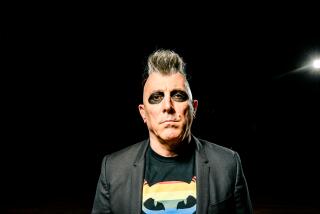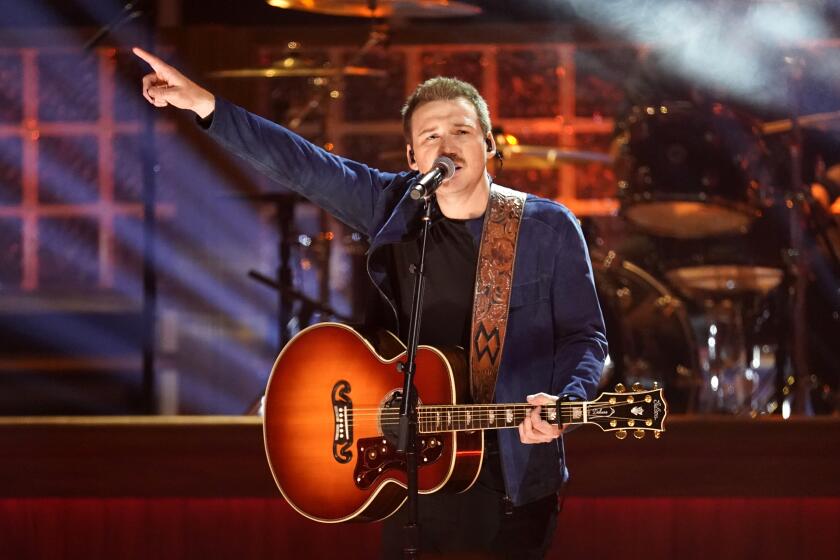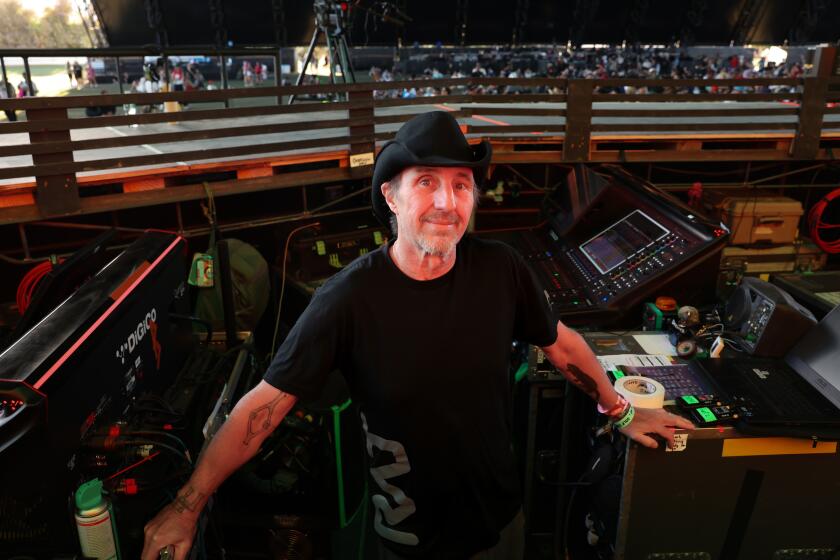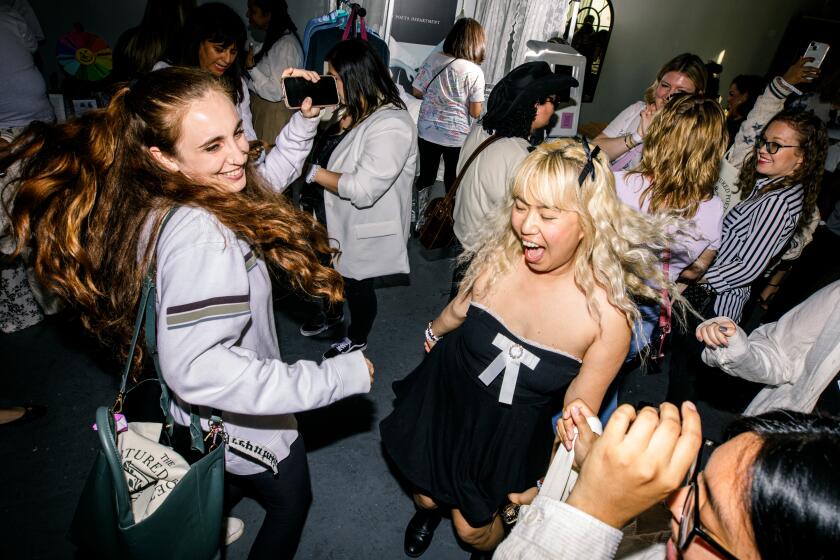Frank talk with Lady Gaga
Almost immediately after she deposited herself in a corner booth at L’Espalier, the restaurant at Boston’s Mandarin Oriental Hotel on the December afternoon after the first American date of her Monster Ball tour, Lady Gaga made a confounding statement.
“I don’t see myself as ever being like anybody else,” said the 23-year-old known to her mom (eating lunch nearby) as Stefani Germanotta. “I don’t see myself as an heir.”
Yet there she was, in a blond Hollywood bob and black tuxedo-bra combo much like the costumes Madonna wore 20 years ago, discussing a show that conjures the spirits of Michael Jackson, David Bowie and the punk-rock drag queens of downtown New York and promoting music -- the newly expanded edition of her 2008 debut album, “The Fame,” greatly enriched by eight new songs and repackaged as “The Fame Monster” -- that pays blatant homage to ABBA, Queen, Eurodisco and Marilyn Manson.
Gaga doesn’t care. She wants you to trace her references. “ John Lennon talked about how with every song he wrote, he was thinking of another artist,” she said, making a less expected connection to a pop deity.
She’s yet to attain the status of the Beatles, but in the ever-accelerating pop cycle, Gaga is a top sensation, and many people’s vote for the most exciting artist of 2009. “The Fame” has sold nearly 2 million copies in the U.S. and reportedly double that internationally; her album and the single “Poker Face” both made the top three on the year-end tally of top iTunes downloads.
“The Fame Monster” continues this sales sweep, but it also considerably advances Gaga’s artistic project with some of her strongest songs yet, including the earworm-infested “Bad Romance” and the sumptuously emotional ballad “Speechless.”
The world is responding. She’s made friends with Madonna, been interviewed by Barbara Walters and met the Queen of England at the annual Royal Variety Performance. The Monster Ball has sold out multiple nights in major cities including Los Angeles, where it comes to the Nokia Theater at L.A. Live for shows Dec. 21-23.
This is all happening not because Gaga is cute or takes off her clothes but because (to use one of her favorite words) she is a monster -- a monster talent, that is, with a serious brain.
During nearly two hours of conversation, she not only reiterates her assertion of total originality but also finesses it until it’s both a philosophical stance about how constructing a persona from pop-cultural sources can be an expression of a person’s truth -- à la those drag queens Gaga sincerely admires -- and a bit of a feminist act.
“I’m getting the sense that you’re a little bit of a feminist, like I am, which is good,” she said. “I find that men get away with saying a lot in this business, and that women get away with saying very little . . . In my opinion, women need and want someone to look up to that they feel have the full sense of who they are, and says, ‘I’m great.’ ”
Gaga’s casual use of the term “feminist” was interesting; like many female pop stars, she’s rejected the term in the past. But she’s evolving. She is growing “more compassionate,” she says, and focusing more on ideas of community, especially the one formed by her core fan base, a mix of gay men, bohemian kids and young women attracted by Gaga’s style and her singable melodies.
Grand declarations
Her new songs address serious themes like women’s shame about their bodies and the need for open communication in relationships; her often physically distorting costumes show that the pursuit of the feminine ideal is far from natural. Her commitment to confront the changing notion of what’s “natural” puts Gaga on the same road traveled by artists she admires, such as the photographer Cindy Sherman. Her frank talk about how female artists aren’t expected to write their own songs or about how young women are afraid to ask for what they need from their sexual partners inches her toward a new articulation of feminism.
“If you ask somebody where you see sexism in your life, all they think of is the old stuff,” said Nona Willis Aronowitz, co-author of the new book “Girldrive: Criss-Crossing America, Redefining Feminism,” by phone. “Equal pay, that’s not really on their radar. Domestic violence and rape aren’t necessarily in the forefront. But you ask about double standards or restrictive gender roles, they don’t think of that as sexism; they think of that as the way it is. That’s kind of like what Lady Gaga is talking about.”
Gaga does view her music as a liberating force. “When I say to you, there is nobody like me, and there never was, that is a statement I want every woman to feel and make about themselves,” she continued. “I don’t make it as a defense. I make it as, OK, guys, it’s been two years, and I’ve made a lot of music, and I know my greatness is individual. And I want every woman to be able to say that.”
This is one of Gaga’s gifts, maybe the one that most distinguishes her from the other talented women directing the pop zeitgeist right now, such as her recent collaborator Beyoncé, her fellow couture hound Rihanna or her rival in redefining blondness, Taylor Swift. Gaga makes outrageous declarations -- which, when you break them down, actually make sense. And then she backs them up, not only through her now famously provocative interviews but in her videos, her collaborations with designers and artists, her live performances and those infernally catchy hits.
Upending genres
As good a game as she talks, Gaga’s real language is visual and, of course, musical. Discussing videos like the one for “Bad Romance,” which she says is about “how the entertainment industry can, in a metaphorical way, simulate human trafficking -- products being sold, the woman perceived as a commodity,” or the Ace Bandage-adorned costume she wore at the American Music Awards, which she said was “meant to be feminine, healing, bondage gothic,” she sounds more like an art critic than an evolving club kid.
“It’s a feeling,” she says of the way she builds these little horror musicals. “There is a narrative, but the narrative isn’t nearly as important as the images are, sewn together.”
As for the songs that serve as the foundation for all of her other forms of expression, Gaga says she never wanted them to be anything but massive hits. “I don’t want to make niche-oriented music,” said the songwriter, who entered the music business writing hits for other artists, including Britney Spears. “I don’t like it! I don’t mean that to be in a rude way. But my taste is not there.”
At a time when pop genres are colliding and collapsing, Gaga is contributing to their downfall. She notes that “Boys Boys Boys,” the first song that she wrote with her main producer RedOne, is a club track that borrows its “gang chorus” from the hard rock of AC/DC. “I told him, I want to make pop music that my heavy metal friends will listen to,” she explained.
“Aside from her few piano ballads, which are like early 1970s Elton John, her dance music is pretty much on-the-money current Euro dance,” said her recent collaborator Adam Lambert in a separate interview. “But she’s a rock star in her mentality. [Her attitude is] like, ‘I hope this makes you look. I’m going to be subversive and out there because it makes me feel good and liberated to be that way.’ ”
It’s arguable that Gaga could only realize her artistic vision in the center of the pop mainstream. Her critical supporters laud her for reconnecting pop to other cultural forms and for revitalizing the stream of art-into-pop first opened up by bands like Roxy Music and the Patti Smith Group.
But she’s not alone in that effort. Kanye West played a gala at the Museum of Contemporary Art before she did; Beyoncé referenced Bob Fosse. Go a notch lower in visibility, as Gaga’s critics point out, and examples abound of rock and club kids with art connections, from Karen O to Alison Goldfrapp.
Gaga has done something more specific: She’s tapped into one of the primary obsessions of our age -- the changing nature of the self in relation to technology, the ever-expanding media sphere, and that sense of always being in character and publicly visible that Gaga calls “the fame” -- and made it her own obsession, the subject of her songs and the basis of her persona.
“Celebrity life and media culture are probably the most overbearing pop-cultural conditions that we as young people have to deal with, because it forces us to judge ourselves,” she said. “I guess what I am trying to do is take the monster and turn the monster into a fairy tale.”
That stars embody the social concerns of their age is a pop-culture truism. But only rarely does an artist dig beneath the dermis of our shared anxieties, exposing the liquid matter that runs through the shared fantasies and delusions of a particular moment.
“It’s kind of like a crusade in its own way,” she said. “Me embodying the position that I’m analyzing is the very thing that makes it so powerful.”
Owning her image
Since the release of “The Fame,” Lady Gaga has been uncovering new layers within her basic themes. At first she just seemed like the most pop savvy of the clever young people using club beats as a basis for music that could be both cerebral and cathartic -- the way indie rockers used heavy guitars a generation before. It was easy to dismiss her as no more than a well-educated New York girl with a gift for pop hooks and self-marketing.
But then her public appearances began to not simply provoke but disturb. She made a video for her song “Paparazzi” that had her in gilded crutches and a leg brace. She turned that vision of crippled glamour even bloodier on the MTV Video Music Awards, an appearance she described as “my first truly original moment.”
She’s worn costumes that recast childhood icons like Kermit the Frog and Hello Kitty into ingénue’s pelts. (The Kermit dress was designed by Jean-Charles de Castelbajac, who’d previously adorned Madonna in teddy bears; the kitty couture was the brainchild of Gaga’s main creative partner, Matthew “Matty Dada” Williams.) She’s painted her eyes to look like an anime heroine. In the climactic dance sequence from Monster Ball, she adorns herself in the black feathers of a vulture and the yards-long blond braids of a victimized princess.
“I had a different vision for it in the beginning. Dada thought it should be braided, and I said, ‘I never wear my hair braided.’ He said, ‘I know, but it’s so Rapunzel, and it’s something people deeply understand. And when you’re wearing sunglasses on a scaffolding piece with a giant alien dancing behind you, I promise you it’s not going to look like Rapunzel.’ ”
The hairpiece does look like something concocted by crafty kids in a basement; it reflects a key element of Gaga’s aesthetic, the do-it-yourself spirit that contrasts with her taste for million-dollar couture. She works with major designers such as Alexander McQueen, who created many of the Monster Ball costumes, but also with newcomers like Gary Card, who made the skeletal headgear she and her dancers wore on the AMAs.
“The great thing about Gaga is she always want to push for the most extreme option,” Card said. “She’s brave enough to let herself be a canvas for a designer to go and really express themselves. Nothing is off limits! With Rihanna and Beyoncé there is an end result of desirability and unattainable sexiness, whereas Gaga is a really interesting bridge between the desirable and the grotesque. She’s not at all worried about looking ridiculous or hideous; actually, I think she thrives off it.”
If Gaga is to maintain her distinctiveness, she’ll need to preserve her orientation toward art as kids putting on a show. It’s what connects her performance of fame to Andy Warhol’s vision instead of Simon Cowell’s. She’s been derided for constantly citing the Pop pioneer, but the connection is real.
Having gotten her start in the bohemian enclaves of downtown New York City, Gaga is deeply indebted to Warhol’s “Superstar”-oriented Factory scene and its aftermath, which produced drag performers like Candy Darling, artists such as Robert Mapplethorpe and streetwise rock stars including Lou Reed and Patti Smith, who declared glamour accessible to anyone with a Polaroid camera, a glue gun or a cheap guitar.
“The idea is, you are your image, you are who you see yourself to be,” she said. “It’s iconography. Warhol and I both went to church when we were younger. That’s how I see things. I don’t want anyone to feel trapped by their own lives. That to me is more dangerous than anything.”
On fantasy island
In Gaga’s movie, she is both Andy and the Superstar. Warhol supported and exploited a coterie of outsiders who likely would never have emerged from their corners without his help. Gaga takes control but also shows herself losing it; she blurs the lines between self-realization and self-objectification, courting the dangers of full exposure for a generation of kids born with camcorders in their hands.
Though she talks nonstop about liberation, Gaga’s work abounds with images of violation and entrapment. In the 1980s, Madonna employed bondage imagery, and it felt sexual. Gaga does it, and it looks like it hurts.
She says she wants her fans to feel safe in expressing their imperfections. “I want women -- and men -- to feel empowered by a deeper and more psychotic part of themselves. The part they’re always trying desperately to hide. I want that to become something that they cherish.”
But what is this freakishness, which she hopes to nurture? In songs like “Poker Face” and the new “Speechless,” Gaga focuses on women as unreliable narrators, misunderstood or even unable to speak. When she presents herself as a cartoon character or a space alien, she explores old questions about gender, artifice and “reality” using the new language of social media, body modification and transgender sexuality.
These deep issues are her tools, as important to her art as the glitter and latex in which she shrouds herself. “If you’re on an island, stranded, and all you have is sticks and leaves and pineapples, you’re gonna make a boat out of sticks and leaves and pineapples,” she said. “I view glamour and celebrity life and these plastic assumptions as the pineapples. And I spend my career harvesting pineapples, and making pies and outfits and lipsticks that will free my fans from their stranded islands.”
More to Read
The biggest entertainment stories
Get our big stories about Hollywood, film, television, music, arts, culture and more right in your inbox as soon as they publish.
You may occasionally receive promotional content from the Los Angeles Times.






